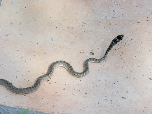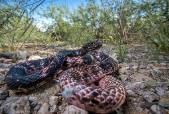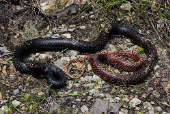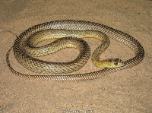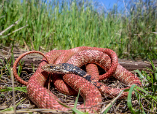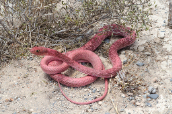Coachwhips (Masticophis flagellum)
Description: Coachwhip snakes are one of the most varied snake species in North America. They are distinctly classified by their smooth scales. There are variations on the physical presentation of the species that correlate with the geographic placement of the population. Generally, the species' populations located on the eastern side of the Mississippi River vary from those on the western side. Though there are variations between and within subspecies, their colorations lend towards camouflage. Coachwhip snakes generally presents as dark brown on the anterior, dorsum portion of their body, while the midline, venter is red or pink. Coachwhip snakes are one of the largest snakes in North America, with adults ranging from 91.4 to 259 cm measured snout to vent.
Subspecies of coachwhips vary is physical presentation. Eastern coachwhips have a very dark anterior dorsum that is lighter in southern geographic locations and darker in northern locations. Sonoran coachwhips present with black bands broken up by small red bands. This trend is seen mostly in the northern geographic range, as this subspecies has been found to solid-colored in the southernmost portions of its geographic range. Western coachwhips have a pink phase on the ventral location with three distinct color patterns being supported there. The idea of polymorphism supports that coachwhips have a light and dark phase where red coachwhips and Baja California coachwhips colors range from yellows, reds, and light greys, to blacks and dark greys.
Juvenile coachwhip snakes have a different color pattern than adult coachwhip snakes. Adults can present with several color patterns depending on region and subspecies while juveniles are commonly a solid tan or brown with white spots on their snouts.
Habitat: Coachwhips are most common in open habitats with sandy soils. Preferred habitats include open pine forests, sandhill scrub habitats, coastal dunes, old fields, and prairies. They are also occasionally found in modified habitats such as power line right-of-ways and agricultural areas.
Range: Coachwhips are found throughout the southern United States from southeastern North Carolina to central California. In our region they are present in all but the mountainous areas of northern Georgia and northwestern South Carolina. Coachwhips are found throughout the Coastal Plain but are uncommon and patchily distributed in the Piedmont. They are particularly abundant in sandhills and coastal areas, including barrier islands.
Diet: Coachwhips have large eyes and are fast and agile hunters. They often hold their heads well above the ground while searching for lizards, mice, and other snakes. They are not constrictors, but simply chase down and swallow their prey alive. Coachwhip snakes are a nonvenomous species. Their diet consists primarily of lizards, other snakes, insects, birds and their eggs, and infrequently various amphibians. Researchers have documented instances where coachwhips have consumed rodents as well as carrion, but it is done rarely. Coachwhip snakes are a foraging species and actively search for their prey.
Reproduction: Male coachwhip snakes seek out a breeding partner and initiate courting behaviors that instigate copulation. Males will display aggressive behaviors, such as flicking of the tongue, to assert dominance and ensure copulation with females. Courting behavior preceding copulation has been recorded to last 4 to 90 minutes while copulation lasts 15 minutes to 130 minutes. Females are polyandrous, breeding with several males during the breeding interval. Males have been observed defending a female they have mated with from other males, attempting to prevent further copulations. To have the greatest chance of copulation, male coachwhip snakes may defend a location from other male coachwhip snakes during the breeding season. This territorial behavior is not present outside of the breeding season. Once copulation and gestation periods have completed, female coachwhip snakes commonly lay their eggs in a nest located inside of a small animal burrow.
Coachwhip snakes are oviparous and iteroparous. They breed once a year between June and August. Males reach maturity at age 1, but it's unlikely he'd be successful in mating until age 3. Females also reach reproductive maturity at age 3. The female gestational period is an average of 77.5 days. Coachwhip snakes lay between 4-24 eggs, with an average of 11 eggs each clutch. The eggs are oblong and white with a granular surface, approximately 35-48 mm in length and 17.8-26.3 mm in width. Coachwhip snakes are not dependent upon a parent after they hatch.
Coachwhip snakes reproduce sexually with the males playing an active role in the process. Female snakes have been shown to display a significantly less active lifestyle than their male counterparts in the height of breeding season, with males being more active throughout the day than females. This difference in activity level dissipates as the breeding season ends, while males and females are equally as active.
Status: Listed as Least Concern in view of its extremely wide distribution, presumed large population, no major threats, and because its population is not currently in decline.
This article uses material from the Wikipedia article "Masticophis flagellum", which is released under the Creative Commons Attribution-Share-Alike License 3.0. Content may have been omitted from the original, but no content has been changed or extended.
|


